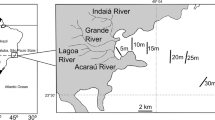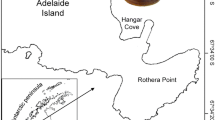Summary
Population structure and aspects of the reproductive biology of Antarctomysis maxima from South Georgia and the South Orkney Islands were examined. Size frequency analysis indicated that the generation time is two years at South Georgia, but may approach four years at the South Orkneys. Egg production is greater for a given size of female at South Georgia but by virtue of a larger egg, brood production in terms of ash-free dry weight is slightly greater at the South Orkneys. Young are brooded over winter at both sites and are released in spring. Females are clearly capable of breeding twice at South Georgia and it is suggested that this is also the case at the South Orkneys. These results are discussed in relation to other studies on cold water mysids and to environmental adaptations exhibited by other Antarctic marine invertebrates.
Similar content being viewed by others
References
Baker A de C (1959) Distribution and life history of Euphausia triacantha Holt and Tattersall. Discovery Rep 29:309–340
Bone DG (1972) Aspects of the biology of the Antarctic amphipod Bovallia gigantea Pfeffer at Signy Island, South Orkney Islands. Br Antarct Surv Bull 27:105–122
Brattelid TE, Matthews JLB (1978) Studies on the deep water pelagic community of Korsfjorden, Western Norway. The dry weight and calorie content of Euchaeta norvegica (Copepoda), Boreomysis arctica (Mysidacea) and Meganyctiphanes norvegica (Euphausiacea). Sarsia 63:203–211
Cassie RM (1954) Some uses of probability paper in the analysis of polymodal size distributions. Aust J Mar Freshwater Res 5:513–522
Childress JJ, Price MH (1978) Growth rate of the bathypelagic crustacean Gnathophausia ingens (Mysidacea: Lophogastridae). 1. Dimensional growth and population structure. Mar Biol 50:47–62
Clarke A (1979) On living in cold water K-strategies in Antarctic benthos. Mar Biol 55:111–119
Clarke A (1980) A reappraisal of the concept of metabolic cold adaptation in polar marine invertebrates. Biol J Linn Soc 14:77–92
Clarke A (1982) Temperature and embryonic development in polar marine invertebrates. Int J Invert Repro 5:71–82
Clarke MR (1969) A new midwater trawl for sampling discrete depth horizons. J Mar Biol Assoc UK 49:945–960
Clutter RI, Theilacker GH (1971) Ecological efficiency of a pelagic mysid shrimp; estimates from growth energy budget and mortality studies. Fish Bull Nat Oceanic Atmospheric Administration US 69:93–115
Denys CJ, McWhinnie MA (1982) Fecundity and ovarian cycles of the Antarctic krill Euphausia superba (Crustacea, Euphausiacea). Can J Zool 60:2414–2423
Fudge H (1968) Biochemical analysis of preserved zooplankton. Nature (London) 219:380–381
Ishikawa M, Oshima Y (1951) On the life history of a mysid crustacean Neomysis japonica Nakazawa. Bull Jpn Soc Sci Fish 16:461–477
Jepsen J (1965) Marsupial development of Boreomysis arctica (Kröyer 1861). Sarsia 20:1–8
Lasenby DC, Langford RR (1972) Growth, life history and respiration of Mysis relicta in an arctic and temperate lake. J Fish Res Board Can 29:1701–1708
Lovegrove T (1966) The determination of the dry weight of plankton and the effect of various factors on the values obtained. In: Barnes H (ed) Some contemporary studies in marine science. Allen and Unwin, London, pp 429–467
Luxmoore RA (1981) The ecology of serolid isopods. PhD Thesis, Council for National Academic Awards, 231 pp
Luxmoore RA (1982) Moulting and growth in serolid isopods. J Exp Mar Biol Ecol 56:63–85
Makarov RR (1970) Biology of the Antarctic shrimp Notocrangon antarcticus (Decapoda Crangonidae) (in Russian). Zool Zh 49:28–37
Makarov RR (1973) Larval development of Notocrangon antarcticus (Decapoda Crangonidae) (in Russian). Zool Zh 52:1149–1155
Makarov RR (1975) A study of repeated maturation of female Euphausia superba (Eucarida Euphausiacea) (in Russian). Zool Zh 54:670–681
Mason JC (1977) Reproductive efficiency of Pacifastacus leniusculus (Dana) in culture. Freshwater Crayfisch 3:101–117
Mauchline J (1965) Breeding and fecundity of Praunus inermis (Crustacea, Mysidacea). J Mar Biol Assoc UK 45:663–671
Mauchline J (1980) The biology of Mysids and Euphausiids. Adv Mar Biol 18:1–681
McLaren IA, Corkett CJ, Zillioux EJ (1969) Temperature adaptations of copepod eggs from the arctic to the tropics. Biol Bull (Woods Hole, Mass) 137:486–493
Murano M (1964) Fisheries biology of a marine relict mysid Neomysis intermedia Czernaivsky. 3. Lifecycle with special reference to the reproduction of the mysid. Jpn Aqua Res Group 12:19–39
Nair KB (1939) The reproduction, oogenesis and development of Mesopodopsis orientalis Tatt. Proc Indian Acad Sci 9:175–223
Peres JM (1982) Major pelagic assemblages In: Kinne O (ed) Marine ecology, vol 5, part 1. Wiley and Sons, New York London Sydney Toronto, pp 187–311
Permitin YE (1970) The consumption of krill by Antarctic fish. In: Holdgate ME (ed) Antarctic ecology, vol 1. Academic Press, London New York pp 177–182
Permitin YE, Tarverdieva MI (1972) The food of some Antarctic fish in the South Georgia area. J Ichthyol (USSR) 12:104–114
Rhodes CP, Holdich DM (1982) Observations on the fecundity of the freshwater crayfish Austropotamobius pallipes (Lereboullet) in the British Isles. Hydrobiol 89:231–236
Steedman HF (1976) General and applied data on formaldehyde fixation and preservation of marine zooplankton. In: Steedman HF (ed) Zooplankton fixation and preservation. UNESCO Press, Paris, pp 103–154
Targett TE (1981) Trophic ecology and structure of coastal Antarctic fish communities. Mar Ecol Prog Ser 4:243–263
Tattersall OS (1955) Mysidacea. Discovery Rep 28:1–190
Wear RG (1974) Incubation in British decapod crustacea and the effects of temperature on the rate and success of embryonic development. J Mar Biol Assoc UK 54:745–762
Wittmann KJ (1981) On the breeding biology and physiology of marsupial development in Mediterranean Leptomysis (Mysidacea Crustacea) with special reference to the effects of temperature and egg size. J Mar Biol Assoc UK 53:261–279
Author information
Authors and Affiliations
Rights and permissions
About this article
Cite this article
Ward, P. Aspects of the biology of Antarctomysis maxima (Crustacea: Mysidacea). Polar Biol 3, 85–92 (1984). https://doi.org/10.1007/BF00258152
Received:
Accepted:
Issue Date:
DOI: https://doi.org/10.1007/BF00258152




